Shigeru Ban and His Cardboard Architecture
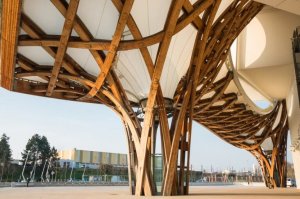
The Japanese architect Shigeru Ban, born in Tokyo in 1957, is perhaps the greatest promoter of cardboard architecture. Ban received the Pritzker Prize, the most significant award in the field of architecture, in 2014.
Shigeru Ban is known not only for constructing buildings of great importance and extraordinary design. He is also known for being one of the architects that often uses sustainable materials.
His cardboard, plastic, and paper designs are some of his most notable pieces. Many also know him for designing emergency shelters in disaster zones and refugee camps.
Shigeru Ban

Ban studied at the Southern California Institute of Architecture (SCI-Arc) between 1977 and 1980. Later he attended the Cooper Union School of Architecture between 1980 and 1984, where architect John Hejduk was one of his tutors. Alongside his studies in architecture, Ban also worked for the Arata Isozaki studio between 1982 and 1983.
In 1985, Ban decided to open his own architecture studio in Tokyo. Although he was born in Japan, he lived for many years in the United States. His training, therefore, gave him quite an occidental style.
Shigeru Ban has dedicated himself to his humanitarian work. He uses architecture as a driving force for social change, despite it traditionally promoting the power and wealth of the privileged few through their constructions. Ban is the founder of the Voluntary Architects Network. He has also researched the use and applications of recyclable materials.
Ban has used paper and cardboard to construct quality shelters and homes at little expense. He has also worked in a wide range of locations. These include Rwanda, India, China, Haiti, and his native Japan.
Shigeru Ban’s cardboard architecture
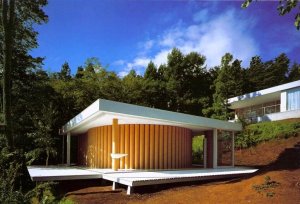
Shigeru Ban first started experimenting with materials in his Tokyo studio in 1985. He then continued working with the material in his studios in New York and Paris. His first projects involving cardboard tubing took place in 1986 when he designed a pavilion inspired by the architecture of Alvar Aalto.
Ban had to consider one decisive factor for this project – he would need to dismantle the structure once the exhibition was over. According to Ban, he came across some cardboard tubing, similar to what he used to store his plans, in the trash when deciding what materials to use.
He then realized that if he used the cardboard tubing in different sizes, he could recreate Alvar Aalto’s shapes and textures.
The pavilion was very successful. This was not just because Ban constructed the building so quickly, but also because it came at such a low cost. He then continued creating architecture and designing many projects in cardboard in the years to come.
Architects can be useful to many people, not only the rich.
-Shigeru Ban-
The cardboard designs of Shigeru Ban
Auditorium L’Aquila (Italy)
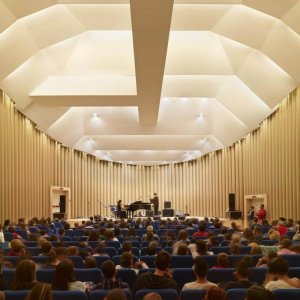
L’Aquila is a small city close to the Italian capital. It was hit by a 6.3 magnitude earthquake on April 6th, 2009, leaving many dead and buildings destroyed.
In response to this urgent and devastating situation, Shigeru Ban designed an auditorium covered in paper and with cardboard columns. This lightweight building fitted perfectly into its surrounding landscape and was entirely eco-friendly, thanks to its natural materials.
The building measures 700m2 and seats up to 230 people. The concert hall forms a diagonal ellipse that measures 25m in length on each side. The structure is made of steel and clay sacks with a prestressed cardboard covering.
IE Business School (Madrid, Spain)
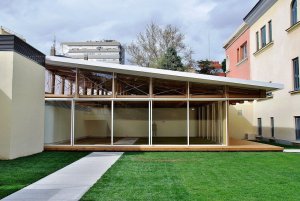
This is the only project Ban has completed in Spain. Opened in March 2013 on the IE Business School Madrid campus, this pavilion has multiple uses, including Executive Education activities and events.
It consists of 173 cardboard tubes with wooden joints that rest on paper columns. This design, despite being small in size, is a clear demonstration of Shigeru Ban’s priorities of sustainability, using innovative materials and helping to develop the local economy.
Takatori Catholic church (Japan)
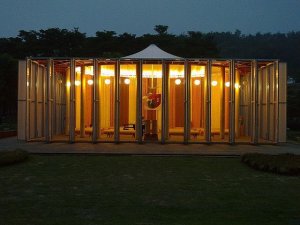
Ban’s Takatori temple is also known as the “Paper Church”. He helped to erect this catholic church for those affected by the earthquake that shook the city of Kobe in Japan.
Similarly to Ban’s other designs, this church was built with recycled materials in just five weeks. Also, Ban’s team needed no heavy machinery, thanks to the help of volunteers.
The church’s center is an oval that consists of 58 paper tubes, which are 5m in length and 33cm in diameter. It can also hold up to 80 people.
Christchurch Cathedral (New Zealand)

In February 2011, a devastating 6.3 magnitude earthquake hit the city of Christchurch, New Zealand. This caused irreparable damage to the city’s 132-year-old gothic cathedral, taking away the community’s place of worship.
Ban designed and constructed a unique replacement. This was a simple structure of paper tubes, with a polyurethane covering, and 6m containers. Thanks to their covering, the tubes are resistant to both water and fire.
The “Cardboard Cathedral”, open since August 2013, can hold up to 700 people.
Through his work, Shigeru Ban has demonstrated the great potential of cardboard, a material that is still in its “experimental” phase. The construction industry will, therefore, need more technical studies and guidelines before it can use cardboard in further projects.
Ban’s greatest success is that he has demonstrated that great architecture, designs, and works of art can come from unconventional materials.
The Japanese architect Shigeru Ban, born in Tokyo in 1957, is perhaps the greatest promoter of cardboard architecture. Ban received the Pritzker Prize, the most significant award in the field of architecture, in 2014.
Shigeru Ban is known not only for constructing buildings of great importance and extraordinary design. He is also known for being one of the architects that often uses sustainable materials.
His cardboard, plastic, and paper designs are some of his most notable pieces. Many also know him for designing emergency shelters in disaster zones and refugee camps.
Shigeru Ban

Ban studied at the Southern California Institute of Architecture (SCI-Arc) between 1977 and 1980. Later he attended the Cooper Union School of Architecture between 1980 and 1984, where architect John Hejduk was one of his tutors. Alongside his studies in architecture, Ban also worked for the Arata Isozaki studio between 1982 and 1983.
In 1985, Ban decided to open his own architecture studio in Tokyo. Although he was born in Japan, he lived for many years in the United States. His training, therefore, gave him quite an occidental style.
Shigeru Ban has dedicated himself to his humanitarian work. He uses architecture as a driving force for social change, despite it traditionally promoting the power and wealth of the privileged few through their constructions. Ban is the founder of the Voluntary Architects Network. He has also researched the use and applications of recyclable materials.
Ban has used paper and cardboard to construct quality shelters and homes at little expense. He has also worked in a wide range of locations. These include Rwanda, India, China, Haiti, and his native Japan.
Shigeru Ban’s cardboard architecture

Shigeru Ban first started experimenting with materials in his Tokyo studio in 1985. He then continued working with the material in his studios in New York and Paris. His first projects involving cardboard tubing took place in 1986 when he designed a pavilion inspired by the architecture of Alvar Aalto.
Ban had to consider one decisive factor for this project – he would need to dismantle the structure once the exhibition was over. According to Ban, he came across some cardboard tubing, similar to what he used to store his plans, in the trash when deciding what materials to use.
He then realized that if he used the cardboard tubing in different sizes, he could recreate Alvar Aalto’s shapes and textures.
The pavilion was very successful. This was not just because Ban constructed the building so quickly, but also because it came at such a low cost. He then continued creating architecture and designing many projects in cardboard in the years to come.
Architects can be useful to many people, not only the rich.
-Shigeru Ban-
The cardboard designs of Shigeru Ban
Auditorium L’Aquila (Italy)

L’Aquila is a small city close to the Italian capital. It was hit by a 6.3 magnitude earthquake on April 6th, 2009, leaving many dead and buildings destroyed.
In response to this urgent and devastating situation, Shigeru Ban designed an auditorium covered in paper and with cardboard columns. This lightweight building fitted perfectly into its surrounding landscape and was entirely eco-friendly, thanks to its natural materials.
The building measures 700m2 and seats up to 230 people. The concert hall forms a diagonal ellipse that measures 25m in length on each side. The structure is made of steel and clay sacks with a prestressed cardboard covering.
IE Business School (Madrid, Spain)

This is the only project Ban has completed in Spain. Opened in March 2013 on the IE Business School Madrid campus, this pavilion has multiple uses, including Executive Education activities and events.
It consists of 173 cardboard tubes with wooden joints that rest on paper columns. This design, despite being small in size, is a clear demonstration of Shigeru Ban’s priorities of sustainability, using innovative materials and helping to develop the local economy.
Takatori Catholic church (Japan)

Ban’s Takatori temple is also known as the “Paper Church”. He helped to erect this catholic church for those affected by the earthquake that shook the city of Kobe in Japan.
Similarly to Ban’s other designs, this church was built with recycled materials in just five weeks. Also, Ban’s team needed no heavy machinery, thanks to the help of volunteers.
The church’s center is an oval that consists of 58 paper tubes, which are 5m in length and 33cm in diameter. It can also hold up to 80 people.
Christchurch Cathedral (New Zealand)

In February 2011, a devastating 6.3 magnitude earthquake hit the city of Christchurch, New Zealand. This caused irreparable damage to the city’s 132-year-old gothic cathedral, taking away the community’s place of worship.
Ban designed and constructed a unique replacement. This was a simple structure of paper tubes, with a polyurethane covering, and 6m containers. Thanks to their covering, the tubes are resistant to both water and fire.
The “Cardboard Cathedral”, open since August 2013, can hold up to 700 people.
Through his work, Shigeru Ban has demonstrated the great potential of cardboard, a material that is still in its “experimental” phase. The construction industry will, therefore, need more technical studies and guidelines before it can use cardboard in further projects.
Ban’s greatest success is that he has demonstrated that great architecture, designs, and works of art can come from unconventional materials.







